Find out how to choose a high-performing sump pump to keep your basement safe and dry.
BobVila.com and its partners may earn a commission if you purchase a product through one of our links.
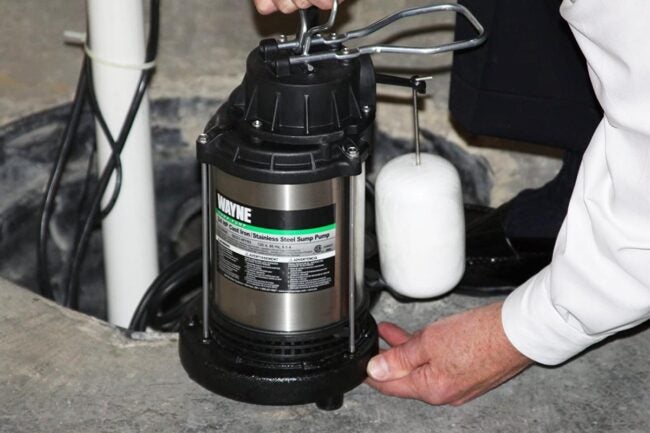
Photo: amazon.com
A good sump pump can be invaluable in an emergency. In times of flooding, a sump pump may provide the only means to save your home from disastrous water damage. Even if your basement isn’t prone to flooding, a sump pump helps prevent mold growth by keeping your basement dry.
Sump pumps reside in a special pit below the basement’s surface or sit on the basement floor. Once the water reaches a certain level, the pump turns on and begins pumping water outside of the home to an area where it can properly drain away from the home’s foundation.
If you’re in the market for a sump pump, read on to learn more about what characteristics you should look for and discover why the sump pumps on this list are some of the best you can buy.
- BEST OVERALL: WAYNE CDU1000 1 HP Submersible Sump Pump
- BEST BANG FOR THE BUCK: Superior Pump 92250 Submersible Sump Pump 1/4 HP
- BEST SUBMERSIBLE: Zoeller M53 Mighty-mate Submersible Sump Pump, 1/3 Hp
- BEST PEDESTAL: Superior Pump 92551 1/2 HP Cast Iron Pedestal Pump
- BEST BATTERY BACKUP: Wayne ESP25 Upgraded 12-Volt Battery Backup System
- BEST COMBINATION: Wayne WSS30VN 1/2 HP and 12-Volt Back Up System
- BEST ENERGY SAVING: The Basement Watchdog Model BW1050 1/2 HP Sump Pump

Photo: depositphotos.com
Types of Sump Pumps
When shopping for a sump pump for your home, there are four main types to consider: submersible, pedestal, battery backup, and combination.
Submersible
A submersible sump pump is designed to work in a pit called a sump basin, located below your basement floor’s surface. When water enters your basement, it flows into the pit. Once the water in the pit reaches a certain level, it triggers a sensor on the sump pump. The pump then turns on and begins pumping water out of your basement via a pipe running to the home’s exterior.
Since the pump sits in a sump basin, submersible pumps are quieter than other sub pumps and are out of the way of other activities that take place in the basement. Typically, they are more expensive than other sump pump types.
If you plan on going with a submersible pump, keep in mind you’ll need to have a sump pump basin dug in your basement floor, which can be an arduous and expensive endeavor.
Pedestal
Unlike submersible pumps, which live in a sump pump basin, pedestal pumps sit on the basement floor. They draw in water from the pump’s base and, like a submersible pump, pump the water through a pipe leading to a drainage area outside the home.
The pump’s motor, which is not waterproof, is located at the top of the unit. Pedestal pumps are less expensive than submersible pumps and don’t require the costly expense of digging a sump pump basin; however, the motor’s position on the unit’s exterior makes them noisier than submersible pumps.
Battery Backup
Pedestal and submersible sump pumps cannot work without electricity, which is significant given that flooding often occurs during storms that knock out power. A battery backup sump pump works similarly to a standard sump pump but uses a battery instead of an electric outlet for power. When a power outage sidelines your sump pump, the battery backup pump will step in to pump water out of the basement.
The average battery-powered sump pumps can pump up to 100 gallons of water on a single charge. Since battery life is limited, a battery backup will eventually give out during extended power outages.
Combination
The best sump pumps include a built-in backup. These versatile units combine a standard electric sump pump with a battery backup, offering max protection for all flooding hazards. Combination pumps use a single pump and are more cost-effective than purchasing two separate pumps.
They also tend to be larger than standard submersible pumps, so if you have an existing sump pump basin, a combination unit may not fit. Check the minimum basin size requirements for the unit before you make a purchase.
What to Look for When Choosing the Best Sump Pump
Knowing the types of sump pumps are out there is crucial, and it’s also important to understand the features to consider when determining which sump pump is best for you.
Basin Space
A standard sump pump basin is 30 inches deep by about 18 inches to 24 inches across, giving it a capacity of around 26 to 30 gallons. A smaller basin causes the unit to work harder, as it will fill more quickly, causing the unit to turn on more often. Different submersible sump pumps require different minimum basin sizes. Those sizes can vary significantly, ranging from 7 inches to 16 inches, so make sure you purchase a submersible pump that will fit the basin in your home.
Core Material
As with any motorized tool or appliance, durability is always an important factor to consider. Sump pumps are built with a surprisingly wide variety of materials. More affordable pumps are made with high-grade plastic that resists wear, while higher-end sump pumps feature stainless steel or heavy cast iron construction. Stainless steel has anti-corrosion properties, while cast iron maximizes cooling ability to better distribute heat from the motor.
The interior of a sump pump is just as important. Impellers, the fan-like mechanism that draws water into the pump, can be plastic or stainless steel, with the latter being the more durable of the two. The shaft that spins the impeller should be made of steel for long lasting functionality.
Power Source
Most sump pumps are electric-powered and feature 9-amp motors. Some energy-efficient sump pumps will operate at about half that amperage, saving you electricity and money. Battery backup sump pumps operate off of a 75-amp hour battery, which provides enough power to operate at a reduced pumping rate for a few hours before a recharge is needed. Combination sump pumps are electric-powered with a 75-amp battery backup that springs into action in a power outage.
Horsepower
Sump pumps range in power from 1/3 horsepower to 1 horsepower. The principle here is simple. The more powerful the motor, the more gallons of water per hour (GPH) the pump can remove. If you have a moderate to low accumulation of water in your basement, then a low flow 1/3-hp pump should suffice. However, if your basement is prone to flooding, it’s best to invest in a more powerful 1-hp sump pump.
No-Screen Intake
When a basement floods, it typically isn’t with crystal clear water. Usually, there is a fair amount of debris floating in it. The sump pump trying to keep your basement dry will inevitably suck that debris into it. Lower-end sump pumps feature screens that filter out this material. That helps keep debris out of the impeller, but screens also eventually clog, reducing the pump’s ability to move water until you manually clean it.
Some pumps feature no-screen intakes that can process that solid material and eject it along with the water. These higher-end pumps are worth the additional investment if you have a basement that floods periodically.
Switch Type
The switch is the part of the pump that turns it on and off. Switch types fall into two categories: digital and manual. Manual pumps use a float that attaches to the switch. When the water rises, so does the float, which flips the switch, turning the pump on. When the water level drops, the float drops, and the switch turns off. These floats can work on a tether that hangs next to the pump or on a vertical rod, which hangs below the pump. While these are effective for most homeowners, this type of switch can sometimes get hung up, especially if the pump basin is small, causing it to malfunction.
A digital switch is mounted vertically in the basin and features two sensors: an on sensor and an off sensor. When the water rises to a certain level, it triggers a sensor that turns the pump on until the water level drops to the off sensor, which shuts the pump off. Unlike manual sensors, which switch on or off based on one set level, a digital sensor allows the pump to run until it reaches the second sensor before switching off. This allows the pump to operate until the basin is nearly empty.
Alerts
Some sump pumps will sound an audio alarm when the pump turns on, letting you know there is enough water accumulating in the basement to require its services. There are even high-end “smart” sump pumps that will text you when they switch on.
Accessories
You need more than just the pump itself when setting up a sump pump in your basement. If you’re using a submersible sump pump, you’ll need a sump pump basin and cover to hold the pump. Basins come in various sizes, so make sure you know what size the sump pump you are purchasing requires.
You’ll also need a discharge hose that carries the water from the sump pump to an area outside your home that drains away from the house. If you’re purchasing a combo kit or battery backup unit, you will need to buy a battery for the unit. Sump pumps typically run off of 75-amp hour batteries.
Our Top Picks
Read on to review our top picks for sump pumps in a variety of categories. This list includes some of the highest-performing units you can buy from the industry’s most reputable manufacturers.
Best Overall
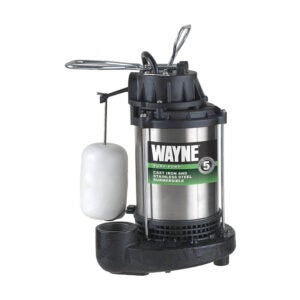
A powerful unit capable of pumping out thousands of gallons of water in an hour is a sensible option for basements prone to flooding. With a 1-horsepower engine and 1.5-inch diameter discharge, this sump pump can move up to 5,400 gallons per hour to a height of 10 feet. This makes it one of the most powerful submersible sump pumps you can buy.
It’s made of durable cast iron and stainless steel construction. It also features a top suction design, eliminating the dreaded air lock problem that can stop some sump pumps in their tracks. A large float operates a manual switch, automatically turning on when water reaches a set level. This pump will work in sump pump basins 11 inches in diameter or larger.
Best Bang for the Buck
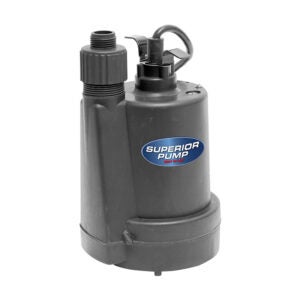
There’s no need to spring for a pump with firehose-like power for basements with minor water issues. A light-duty sump pump such as this one from pump specialist Superior Pump will do its job well. With a 1/4-horsepower motor, this submersible style pump is a great option for basements that face occasional light to moderate flooding. It’s capable of pumping out up to 1,200 gallons per hour to a height of 10 feet. It features a suction screen that filters out up to 1/8-inch solids.
The pump’s body is constructed of thermoplastic, which resists corrosion. An adapter allows for easy hook up of a 1-1/4-inch discharge hose or standard garden hose while a float automatically turns the unit on and off. This budget-friendly sump pump is a highly functional option for basements that experience minor flooding.
Best Submersible
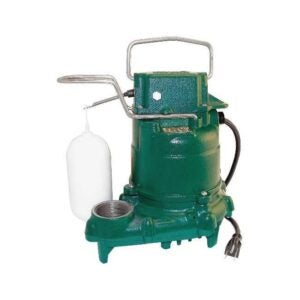
Given that submersible pumps spend their lives in murky, damp sump pump pits, durable materials are necessary for them to hold up to wet environments. With its cast iron construction, this green sump pump from Zoeller is built for these conditions. It features a 3/10 horsepower motor capable of pumping out more than 2,500 GPH to a height of 5 feet, ideal functioning for basements with moderate flooding problems.
The Zoeller M3 is also powerful enough to pass solids up to a 1/2-inch in diameter. A large float regulates the on/off switch at a water depth of just over 19 inches. The pump also includes a built-in thermal overload to prevent damaging the motor from overheating.
Best Pedestal
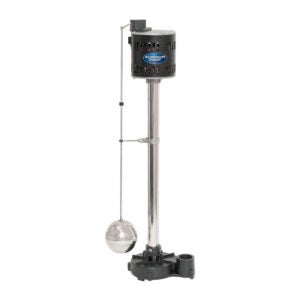
A good pedestal pump will keep its vulnerable motor safely out of harm’s way while performing its duties. With its 3-foot height, this pedestal-style pump from Superior Pump keeps its powerful 1/2-horsepower motor dry while its five-bladed impeller pumps out up to 3,600-gallons per hour or 2,700 GPH to a height of 10 feet. With its impressive motor and tall design, this pump is a great option for basements that flood regularly.
Features include durable stainless steel construction and a heavy cast iron base for stability. An adjustable float switch turns the pump on or off based on water depth. Pedestal sump pumps can be bulky, taking up valuable real estate in a basement, but this sump pump’s tall and thin profile keeps it safely out of the way.
Best Battery Backup
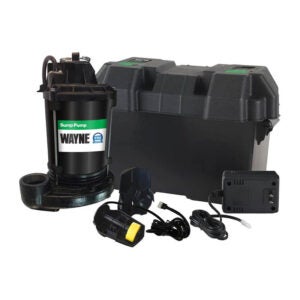
When the storm is raging, and the power goes out, unless you have enough family members to form a bucket brigade, you’d better have a quality battery-powered sump pump to keep your basement from filling with water. This 12-volt battery backup system is your stopgap against a flooding disaster.
It uses a 75-amp hour battery to produce up to 2,700 gallons per hour of pumping volume—It can pump up to 10,000 gallons of water on a single charge. Cast iron construction makes this a durable pump while top suction design prevents airlocks from happening. The kit comes with a waterproof protective battery case that features an LED display and emits an audible alarm when the pump switches on.
Best Combination
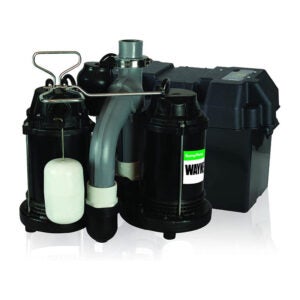
For wet areas that experience regular flooding and power outages, you need a powerful sump pump that will keep your basement dry whether there’s power or not. This combination sump pump comes equipped with a 1/2-horsepower motor capable of pumping out up to 5,100 gallons per hour when the power is on and up to 2,900 GPH when it isn’t. Operating off of a 75-amp hour battery, this submersible sump pump will continue operating for hours after the power goes out.
The unit conveniently switches over to battery power during outages, preventing delays in pumping. This system will work in sump pump basins 16 inches in diameter and larger. A waterproof case with digital display protects the battery.
Best Energy Saving
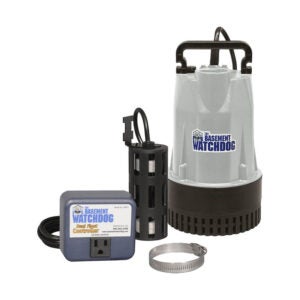
Pumping water out of the basement with an electric sump pump can get costly, especially if you live in a wet area that forces your pump to work overtime. If you’re worried about energy costs, then check out the Basement Watchdog. This 1/2-horsepower submersible pump will keep your carbon footprint in check thanks to a split capacitor motor that only pulls 4.2 amps of energy— that’s about half the amount of amps that similarly powered sump pumps use. And while you might think the trade-off comes in power, it doesn’t—this sump pump can move up to 4,400 gallons per hour or 3,540 GPH at 10 feet.
The Basement Watchdog features a double-float power switch system for redundancy and a compact design—this sump pump will fit in pits as small as 7 inches in diameter.
FAQs About Your New Sump Pump
If you have lingering concerns about sump pumps, read on for the most common questions.
Q. Where should the extra water be drained by a sump pump?
Sump pumps use a drain hose to remove water from your basement. A drain hose should extend outside of your home to an area on your property that drains away from your house. This is crucial. You don’t want the water you just pumped out to run back into your basement, starting the cycle all over again.
Q. How often does a sump pump need to be cleaned?
You should clean your sump pump once a year. That said, when your pump tackles an especially hard job, such as removing water from a flooded basement after a bad storm, you should clean it as soon as possible.
Q. How often should you replace sump pumps?
On average, sump pumps last about 10 years. Keep tabs on older units as you likely won’t notice it’s no longer working until water is accumulating in your basement.
tinyurlis.gdv.gdv.htu.nuclck.ruulvis.netshrtco.detny.im
مقالات مشابه
- ترفند های خانه داری و زندگی - بهترین ترفندهای زندگی
- 1 ملوان مجروح فعال تیرانداز 'خنثی' در ایستگاه هوایی نیروی دریایی کورپس کریستی
- شرکت صادرات و واردات کالاهای مختلف از جمله کاشی و سرامیک و ارائه دهنده خدمات ترانزیت و بارگیری دریایی و ریلی و ترخیص کالا برای کشورهای مختلف از جمله روسیه و کشورهای حوزه cis و سایر نقاط جهان - بازرگانی علی قانعی
- شرکت صادرات و واردات کالاهای مختلف از جمله کاشی و سرامیک و ارائه دهنده خدمات ترانزیت و بارگیری دریایی و ریلی و ترخیص کالا برای کشورهای مختلف از جمله روسیه و کشورهای حوزه cis و سایر نقاط جهان - بازرگانی علی قانعی
- نیروی هوایی C-130 بازدید دیوار آتش در عراق شب فرود; خدمه امن
- Airman متهم در قتل افسر فدرال در کالیفرنیا
- اطلاعات تکان دهنده درباره برج خنک کننده Exposur
- تحلیل خبری: بایدن در میان چالش ها «اجلاس سران دموکراسی» را برگزار کرد
- 'Marines Make Excellent Soldiers': Over Half a Marine Tank Company Just Joined the Army National Guard
- شرکت صادرات و واردات کالاهای مختلف از جمله کاشی و سرامیک و ارائه دهنده خدمات ترانزیت و بارگیری دریایی و ریلی و ترخیص کالا برای کشورهای مختلف از جمله روسیه و کشورهای حوزه cis و سایر نقاط جهان - بازرگانی علی قانعی